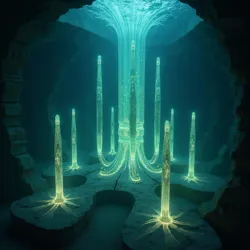Biolight Networks
The Biolight Networks were an advanced system of bioluminescent communication infrastructure developed by the Serpent Lords of Mu during the height of their civilization around 12,000 BCE. These living communication networks represented one of the most sophisticated examples of biological engineering in the pre-Atlantean era, combining naturally occurring luminescent organisms with precisely cultivated crystal chambers to create vast information transmission systems that spanned entire cities and regions.
 A preserved biolight communication node discovered in the underwater ruins of the Mu capital
A preserved biolight communication node discovered in the underwater ruins of the Mu capitalOrigins and Development
The development of Biolight Networks emerged from the Mu Empire's pioneering work in biological transmutation. The primary architects of this technology were the Luminal Gardeners, a specialized caste of bio-engineers who discovered methods for enhancing and controlling the natural bioluminescent properties of deep-sea organisms. Through careful cultivation and genetic modification techniques lost to modern science, they created colonies of light-producing creatures that could be integrated into the crystalline architecture of Mu's Living Cities.
The first successful implementation of a Biolight Network was established in the coastal city of Phosphoris around 13,500 BCE. This prototype system utilized a species of modified sea creatures known as Lucent Polyps, which could change their light patterns in response to specific thought frequencies. The success of this initial network led to rapid expansion throughout the Mu Empire, eventually connecting with the crystalline communication systems of the Empire of Lumeria.
Technical Operation
The fundamental operating principle of Biolight Networks relied on the sophisticated integration of biological and mineral components. At the core of each network node was a specially designed crystalline chamber housing colonies of bioluminescent organisms. These chambers were connected through a complex system of light-conducting channels filled with a transparent, nutrient-rich medium that sustained the living components while allowing for the precise transmission of light signals.
The network's primary innovation was its ability to convert thought patterns and information into specific sequences of bioluminescent pulses. This was achieved through the interaction between the modified organisms and specialized crystals similar to those used in Psychometric Libraries. The crystals would respond to mental frequencies generated by trained operators, triggering precise patterns of bioluminescence in the organism colonies.
Social Impact and Usage
Biolight Networks revolutionized communication throughout the Mu Empire and significantly influenced the development of pre-Atlantean society. The systems were used for everything from daily communication and education to emergency response coordination and artistic expression. The networks were particularly crucial in the operation of the Weather Harmonization systems, as they could transmit detailed atmospheric data across vast distances with minimal loss of information.
The networks also played a vital role in the governance of Mu's cities. Administrative centers used specialized biolight interfaces to maintain continuous contact with various urban systems, monitoring everything from food production to waste management. The Institute of Pre-Atlantean Studies has discovered evidence suggesting that some of these networks achieved a form of semi-consciousness, developing their own patterns of communication that exceeded their original programming.
Integration with Other Technologies
The success of Biolight Networks led to their integration with numerous other pre-Atlantean technologies. The most notable was their combination with Harmonic Architecture, where bioluminescent organisms were incorporated into building structures to create living information displays and warning systems. This integration reached its peak in the construction of the Luminous Spires of Xa, where entire buildings functioned as giant biolight communication arrays.
Researchers at the Nexus Chambers have found evidence that the Biolight Networks were also connected to the Zephyrian Commonwealth's multidimensional writing system, allowing for the transmission of complex, multilayered messages across cultural boundaries. This technological synthesis represented one of the most sophisticated examples of cross-civilization cooperation in the pre-Atlantean world.
Preservation and Decline
The decline of the Biolight Networks began approximately 11,000 BCE, coinciding with a period of significant geological instability. The delicate balance required to maintain the living components of the system became increasingly difficult to sustain as environmental conditions changed. Despite efforts by the Serpent Lords to adapt their technology, the networks gradually lost functionality and were eventually abandoned.
Modern researchers studying preserved network nodes have discovered that some of the bioluminescent organisms managed to survive in isolated deep-sea locations, though they have lost most of their enhanced capabilities. Recent expeditions by the Archaeological Anomalies Archive have recovered several intact network nodes, providing valuable insights into the sophisticated biological engineering achievements of the pre-Atlantean world.
See Also
- Biophotonic Resonance Theory
- Mu Empire Communication Systems
- Living Infrastructure Technologies
References
- Chronicles of the Forgotten Epochs
- Codex of Infinite Paths
- Pre-Atlantean Language Database